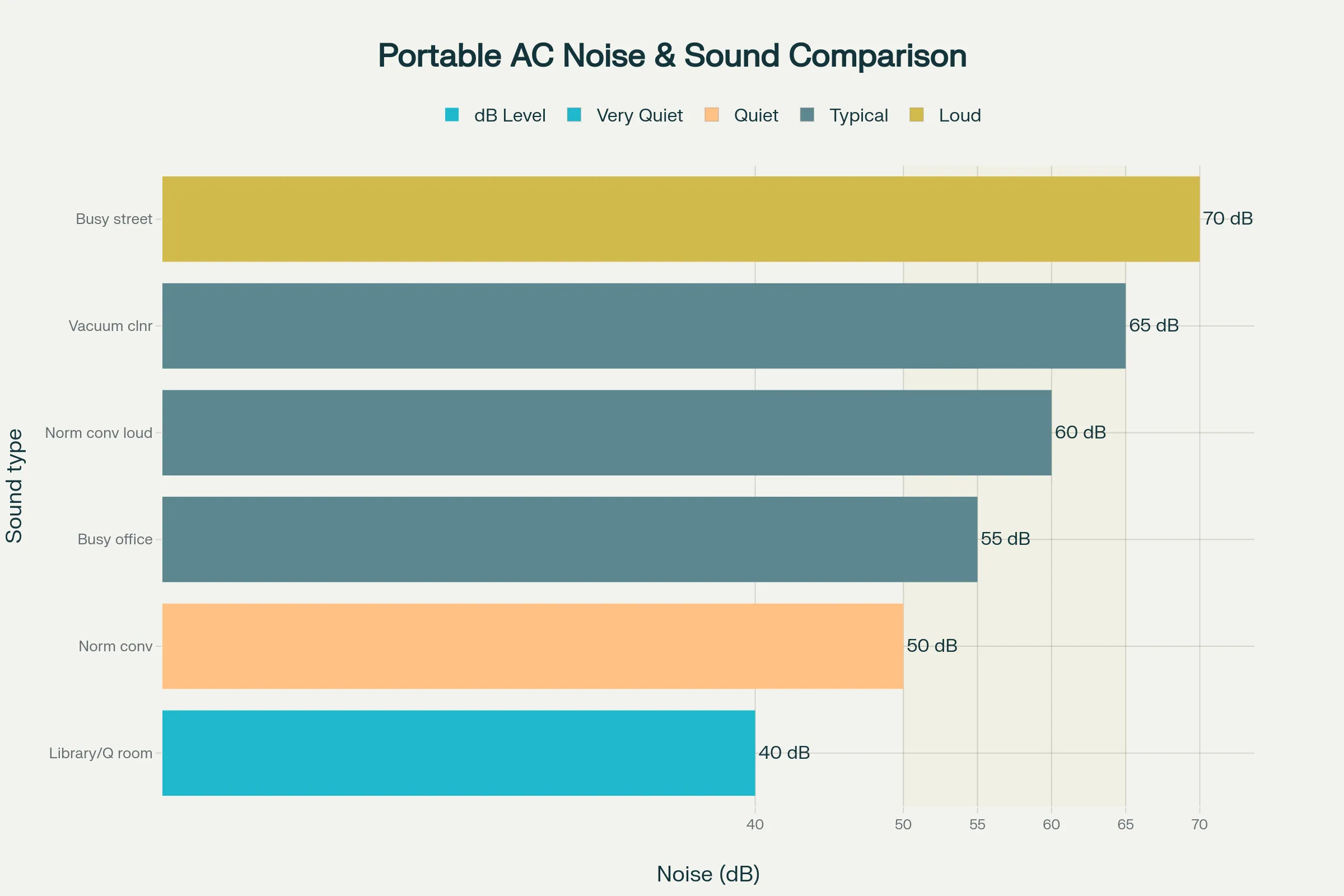Air Conditioner Noise Levels: Complete Guide
Understanding decibel levels, noise ratings, and how to choose the quietest portable air conditioner for peaceful cooling in your home.
Noise levels can make or break your air conditioning experience. This comprehensive guide explains everything you need to know about AC noise ratings, from understanding decibel measurements to finding the quietest units for bedrooms and noise-sensitive environments.
Bedroom Ideal
≤ 50 dB
For peaceful sleep
Living Room Max
≤ 60 dB
For comfortable use
Too Loud
> 65 dB
Disruptive noise level
Understanding Decibels: The Science of Sound
What is a Decibel (dB)?
A decibel is a unit measuring sound intensity on a logarithmic scale. This means every 10 dB increase represents a 10-fold increase in sound intensity - so 60 dB is 10 times louder than 50 dB, not just 20% louder.
Common Sound Levels for Reference:

Click to view larger image
Air Conditioner Noise Ranges Explained
35-45 dB - Ultra Quiet
Premium units with advanced noise reduction
Best For:
Perfect for bedrooms, nurseries, home offices
Common Examples:
High-end inverter models, some mini-splits
45-55 dB - Quiet
Good balance of performance and noise control
Best For:
Suitable for bedrooms, excellent for living areas
Common Examples:
Quality portable ACs, most mini-splits
55-65 dB - Moderate
Standard noise levels for most portable units
Best For:
Fine for living rooms, kitchens, offices
Common Examples:
Mid-range portable ACs, older window units
65+ dB - Loud
Higher noise levels, may be disruptive
Best For:
Only for garages, workshops, or isolated areas
Common Examples:
Budget portable ACs, industrial units
UK-Specific Noise Considerations
Housing Considerations
- Terraced Houses: Shared walls mean noise travels to neighbors
- Flats/Apartments: Floor vibrations can disturb residents below
- Period Properties: Thinner walls and floors in older buildings
Time-Based Guidelines
- Night Use (10 PM - 7 AM): Maximum 45 dB recommended
- Day Use (7 AM - 10 PM): Up to 55-60 dB generally acceptable
- Considerate Practice: Use sleep mode or timer functions at night
Features for Quiet Operation
Compressor Technology
Modern portable air conditioners use various compressor technologies to reduce noise. Inverter compressors, for example, can run at variable speeds, reducing noise by 3-5 dB.
Common Quiet Features:
Sound Dampening
Internal foam padding, vibration-absorbing materials, and sound dampening materials.
Sleep Mode
Reduces fan speed and temperature gradually, minimizing noise.
Quiet Mode
Maximum noise reduction, often under 50 dB operation.
Bedroom Use Considerations
Why Quiet is Important in Bedrooms
Even moderate noise levels can disrupt sleep patterns and negatively affect health. A quiet air conditioner is crucial for a peaceful night's rest.
Ideal Noise Levels for Sleep:
Common Sources of Bedroom Noise:
Practical Noise Reduction Tips
Installation Tips
Proper installation is crucial for quiet operation. Ensure the unit is level, use vibration isolation, and secure exhaust hoses.
Installation Checklist:
Maintenance for Quiet Operation:
Measuring and Comparing Noise Levels
How Manufacturers Measure Noise
Manufacturers typically measure noise in an anechoic chamber (a room with no echoes) at 1 metre distance, under standard temperature and humidity conditions, and in maximum cooling mode. They use A-weighted decibel scale (dBA).
Real-World Differences:
Quietest Portable AC Recommendations
Ultra-Quiet Models
Noise Range: 44-48 dB
Price Range: £400-£800
- Inverter compressor technology
- Advanced sound dampening
- Sleep mode with quiet operation
- Premium build quality
Balanced Quiet Models
Noise Range: 48-54 dB
Price Range: £250-£500
- Standard compressor with optimization
- Multiple fan speeds
- Good build quality
- Energy efficient operation
Budget Quiet Options
Noise Range: 52-58 dB
Price Range: £150-£300
- Basic compressor technology
- Standard noise dampening
- Multiple operating modes
- Reliable operation
What to Look For When Shopping:
Essential Quiet Features
- • Noise rating under 54 dB for living spaces
- • Under 50 dB for bedroom use
- • Sleep mode for night-time operation
- • Variable fan speeds for customization
- • Timer functions for automated quiet hours
- • Inverter compressor for consistent operation
Red Flags to Avoid
- • No noise rating provided by manufacturer
- • Over 60 dB in any operating mode
- • Poor customer reviews mentioning noise
- • No quiet/sleep mode available
- • Unusually cheap pricing for the size
- • Unknown brand with no warranty
Final Recommendation
For most UK homes, prioritize models with noise ratings under 54 dB and inverter compressor technology. The extra cost for quiet operation pays dividends in comfort, better sleep, and neighbourly relations.
Remember: A 3 dB difference in noise rating represents a doubling of perceived loudness. It's worth paying extra for genuinely quiet operation rather than compromising on this crucial comfort factor.
Ready to Find Your Perfect Quiet AC?
Now that you understand noise levels, explore our tools and guides to find the quietest air conditioner for your needs